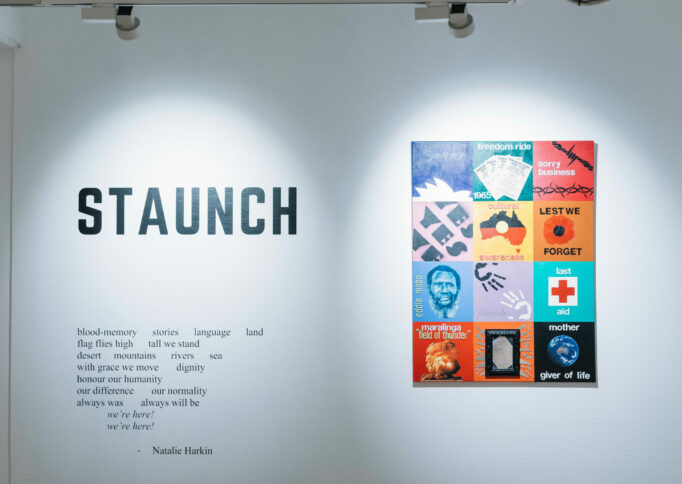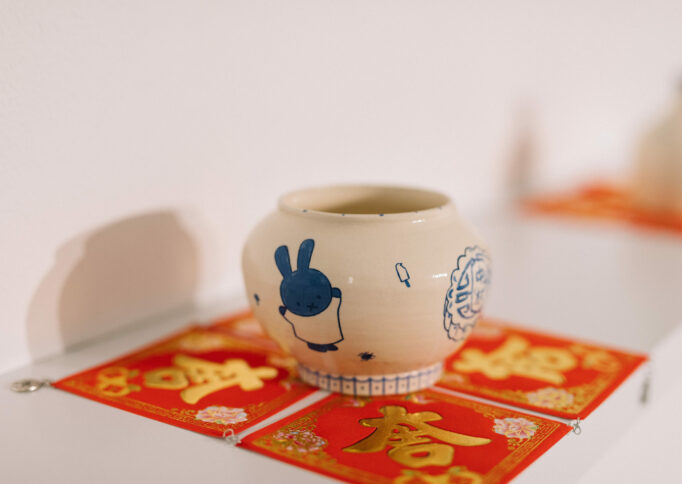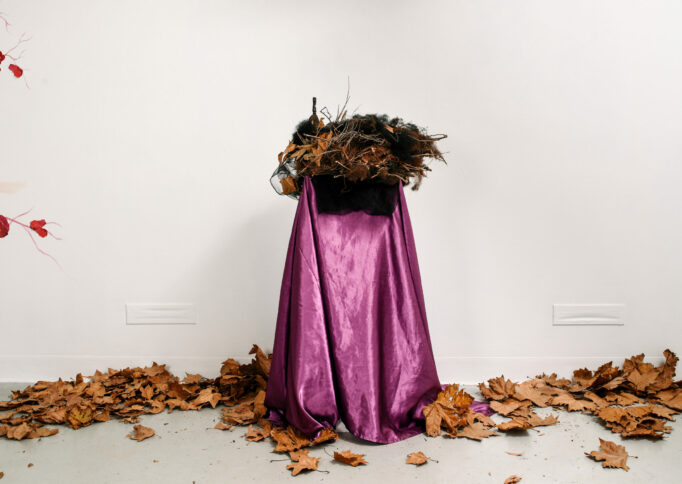Exhibition
internally disPLACEd: borders and belonging
Curated by Dameeli Coates
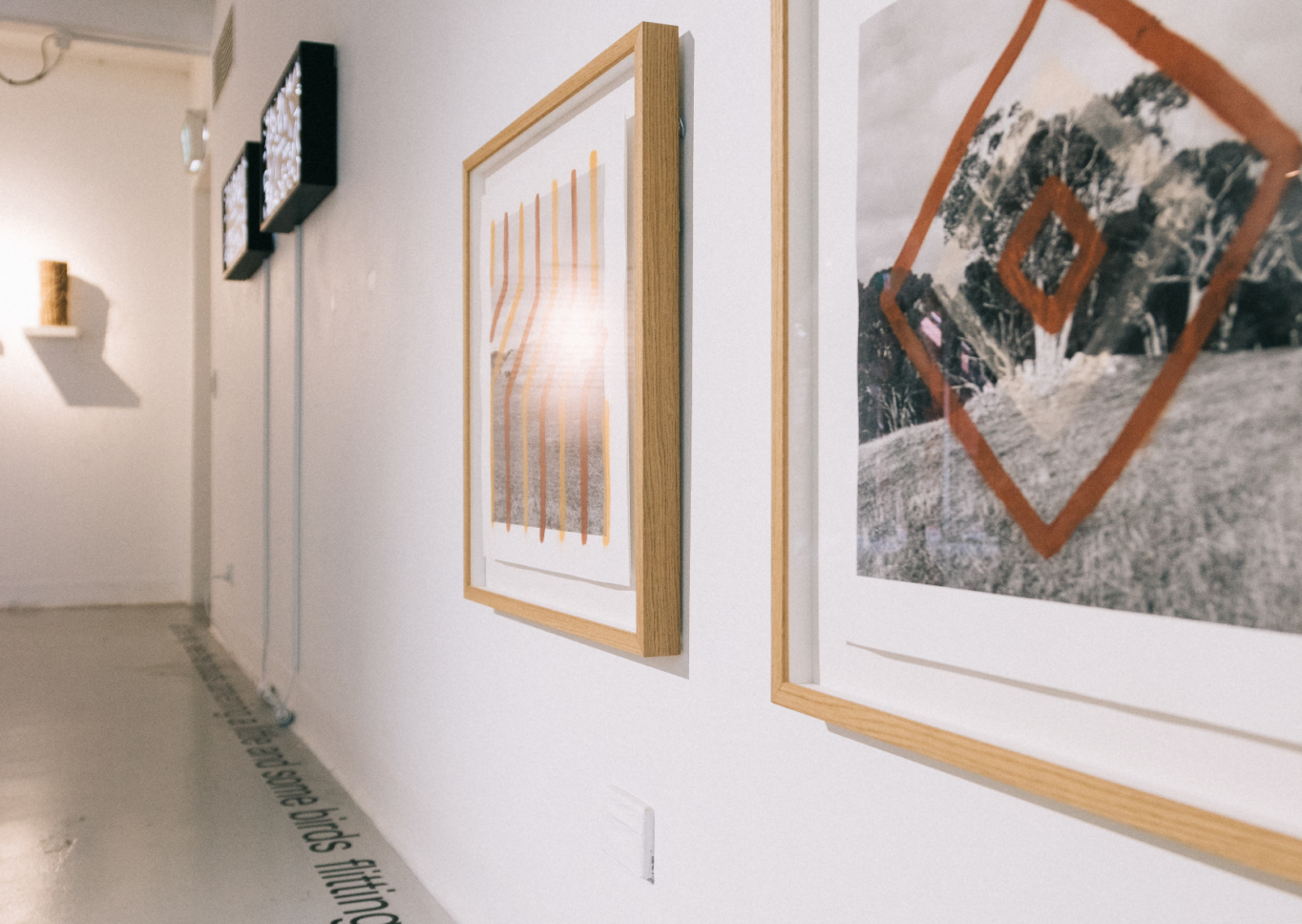
About the exhibition
Supported by Arts South Australia, this is the inaugural In_Site: First Nations Emerging Curator Program, a partnership between Nexus Arts and Flinders University Museum of Art (FUMA). Curated by Dameeli Coates, this exhibition considers the effects of dispersal, displacement and dispossession on Indigenous Australian lives and explores how connections to Country are being maintained through cultural practice.
Indigenous Peoples live in a globalised world, while maintaining a deep connection to land and Country that is an essential part of our identity and culture. As Indigenous Peoples move across borders—because of past or present trauma, politics, love, or as part of our own personal journeys—what are the effects of that movement and how do we reconcile such movement or displacement with the notion of connection to Country?
This exhibition considers the effects of, and parallels between, the colonial project’s attempt to define Indigenous cultural connections and our own interpretation of living “off Country”, and how we carry Country within us and through us.
The exhibition invites the viewer to think differently about the experiences of Indigenous Peoples in a global world and to question imposed colonial views of Country. It ties the experiences of Indigenous Peoples to those of other black and brown people who have experienced movement and speaks to the displacement and emotional toll of intergenerational trauma and the effects of forced movement and racism. It considers Indigenous Peoples’ longing for being on Country and the way we bridge these contemporary experiences culturally with our inalienable right to Country.
internally disPLACEd: borders and belonging
This is an audio description for the exhibition, Internally displaced: borders and belonging, curated by Dameeli Coates and presented by Nexus Arts in partnership with the Flinders University Museum of Art.
This exhibition is in the Nexus Arts Gallery, which is a white rectangular room around 4m wide and 6m long. On the first wall to our left as we walk in is the introductory text.
The text reads:
internally disPLACEd: borders and belonging
The title is written in lower caps, except for PLACE, which is capitalised.
Indigenous Peoples live in a globalised world, while maintaining a deep connection to land and Country that is an essential part of our identity and culture. As Indigenous Peoples move across borders – because of past or present trauma, politics, love, or as part of our own personal journeys – what are the effects of that movement and how do we reconcile such movement or displacement with the notion of connection to Country?
This exhibition considers the effects of, and parallels between, the colonial project’s attempt to define Indigenous cultural connections and our own interpretation of living “off Country”, and how we carry Country within us and through us.
The exhibition invites the viewer to think differently about the experiences of Indigenous Peoples in a global world and to question imposed colonial views of Country. It ties the experiences of Indigenous Peoples to those of other black and brown people who have experienced movement and speaks to the displacement and emotional toll of intergenerational trauma and the effects of forced movement and racism. It considers Indigenous Peoples’ longing for being on Country, and the way we bridge these contemporary experiences culturally with our inalienable right to Country.
Beside the wall text are two tall basket-like sculptures, each situated on a small white square shelf on the wall.
The wall label reads:
Dameeli Coates
Wakka Wakka, born 1976
I carry Country, 2021
Jute, recycled wool, reeds, sheoak nettles
Work created in Tarntanya, Adelaide (Kaurna Land)
Courtesy of the artist
Each cylindrical basket is woven from natural fibres, around 40cm high and 20cm wide, and stands upright in a long column. The basket to the left is woven in shades of light brown jute and dark brown wool, and around its surface bunches of thin sheok nettles are gathered. The long curved nettles are pale brown, and are gathered together in the middle of the bunch with strands of black wool, which secures them to the basket.
The basket to the right is slightly lower down on the wall. Again it features the horizontal weaving of the light and dark browns. Wiry thin green reeds emerge from the basket, gathered wildly around it, some of which are loosely plaited.
–
Moving clockwise around the room, the next wall features work by Jenna Lee and James Tylor.
The first wall label reads:
Jenna Lee
Larrakia, Karajarri, Wardarman, born 1992.
Light of an Invasive Native 2021
Lightbox
Work created in Narrm, Melbourne (Boom Wurrung and Woi Wurrung)
Courtesy of the artist and MARS gallery
This work features 2 black lightboxes, mounted next to each other on the wall, around 1.5 off the ground. Each lightbox is around 50cm long and 30cm high and 10cm deep, and set in a black frame. The glowing faces of the lightboxes display white leaves and blossoms on a black background. In the centre of each lightbox in an archival-looking traditional font are words, placed one on top of the other, the second word slightly lower and set to the right.
The first lightbox reads “Archival”, “Survival,” the lightbox to the right reads “Invasive, Native.”
–
Next along the wall are four framed photographs set in a square formation.
The wall label reads:
James Tylor
Kaurna, born 1986
Turalayinthi Yarta series 2017
Work created in Tarntanya, Adelaide (Kaurna Land)
Marrmiyurna
Photograph with ochre
Wirramiyu
Photograph with ochre
Yarlu
Photograph with ochre and pipeclay
Mukurta
Photograph with ochre and pipeclay
Courtesy of the artist and N.Smith Gallery
Each of these works is a print around 50cm square, surrounded by white mountboard, framed by pale wood. Each print is a black and white photograph of a landscape, overlaid with painted lines.
The top left work, Turalayinthi Yarta (Marrmiyurna) features a landscape of low grass. A thin tree is in the lefthand side of the photo, and the curved horizon is dotted with a few sparse trees. Laid over this is a reddish-brown ochre crosshatch.
The top right work, Yarlu, is a photograph of a coastline. The sea takes up the bottom half of the piece, the sky the top half, and to the right is a coastline of large sloping rocks. Overlaid are alternating wavy lines of white and dark yellow ochre.
The bottom left work, Wirramiyu, is a grassy landscape, with low hills seen in the distance. Overlaid are vertical painted stripes of red and yellow, which head down from the top of the image, move diagonally to the left, and then head straight down again.
The bottom right work, Mukurta, is a photograph of a tall tree on a grassy hill. Overlaid is a dark red diamond in the centre of the work, with a larger dark red diamond around it, its edges reaching almost to the edge of the photograph.
–
Moving clockwise around the room, the next wall features a video work in the centre.
The wall label reads:
Mariaa Randall
Bundjalung, Yaegl
Painting the dance, 2011
Audio visual danced installation
Work created in Naarm, Melbourne (Boon Wurrung and Woi Wurrung)
Courtesy of the artist
Painting the dance is a video work projected onto the white gallery wall. The projection is around 2m wide and 1.5m high. This work also features an eerie rattling sound throughout. In the video, a short-haired Aboriginal woman in a short black dress dances slowly in an all-white space.
She enters the space from the left. She slowly moves her feet over each other, pressing her body against the wall and leaving smears of black paint. She rolls over the wall, slowly gazing around the room. She falls to the floor, smears the floor with paint, raises her hand in front of her, rises and continues along the wall, smearing paint with her back, front, arms and legs.
When she reaches the end of the wall, she slumps with her back to the wall and reaches forward, walks forward towards the viewer.
Then she steps backwards, returning to the wall. She begins to peel white tape off the wall. As it peels back a geometric design is revealed under the paint. She exits the space to the left, bringing the tape with her around her shoulders. She returns with white paint on her hands, smears it across the wall, and slowly leaves again.
–
This exhibition also features artwork from the Flinders University Museum of Art. The next long wall is covered in a salon hand of 11 works from the collection, a mix of printed and painted artworks. The prints all have white mountboard and pale wooden frames.
Lin Onus
Yorta Yorta, born 1948, died 1996
Dislocation, 1986
Linocut, ink on buff paper
Edition 93/100
Work created in Melbourne (Boon Wurrung and Woi Wurrung)
Collection of Flinders University Museum of Art
The first small work on the lefthand side is a small black linocut print within a much larger piece of white mountboard and a pale wood frame. The print features an image of a small child against a background of crosshatched lines. The image is cut horizontally into 8 uneven slices, and each slice moved in an alternating direction, creating the effect of seeing the child through a broken lens.
Mable Juli
Kija/Gidja, born circa 1933
Karrngin Ngarrangkarni 2002
Natural pigments on canvas
Work created in Warmum, East Kimberly, Western Australia (Gija)
Donated through the Australian Government’s Cultural Gifts Program by Stephanieand Julian Grose
Collection of Flinders University Museum of Art
To the right of the print is Mabel Juli’s long brown canvas, featuring two pale crosses surrounded by white dots, and in between them, a crescent shape with the tapered ends pointing towards the ceiling. This shape is also surrounded by white dots.
Eubena Nampitjin
Wangkajunga, born circa 1930, died 2013
Nakarra Nakarra (Seven Sisters Dreaming) 2003
From the portfolio Yilpinji: Love Magic Ceremony
Screenprint, coloured inks on paper
Edition 44/99
Gift of an anonymous donor
Collection of Flinders University Museum of Art
Beneath Juli’s canvas is Eubena Nampintjin’s screenprint.
This square work features many layers of ink. Against a background of orange, white and black, lines of orange and white sweep towards the centre of the work. Covering this are many yellow dots. Small scooped half-circles sit in the bottom right corner and top left, and some darker dots in the top right quarter. In the corner of the top right is a long curve of orange overlaid with white.
–
Nyapanyapa Yunupingu
Gumatj, Yolgnu, born 1945, died 2021
Djulpan, Seven Sisters 2020
Collograph and screenprint, coloured inks on paper
Edition 26/40
Work created in Yirrkala, East arnhem Land, Northern Territory
Collection of Flinders University Museum of Art
To the right of these works is a large printed piece, a series of pale red crosses drawn over a black and silver background. The silver in the background shimmers like pewter.
Mary Kemarre
Alyawarr/Alyawarre, born circa 1925, died 2016
Star dreaming (still chasing seven sisters) 1998
Synthetic polymer paint on canvas
Gift from the personal collection of Rodney Gooch
Collection of Flinders University Museum of Art
Below Yunupingu’s large print is Mary Kemarre’s large black canvas covered in star-like white dots. The dots are further apart in the lower half, and closer together in the top half, where they coalesce into a tiny stick figure.
Kerry Giles
Ngarrindjeri, born 1959, died 1997
Collecting initie seeds in the desert 1992
Screenprint, coloured inks on paper
Edition 5/46
Work created in Tarntanya, Adelaide (Kaurna Land)
Collection of Flinders University Museum of Art
To the right of the canvas is a smaller printed work by Kerry Giles. In this print, the landscape in the top half is mirrored in the bottom half. The colours are bold and flat. In the centre is an undulating beige line featuring human footprints and many small red semi-circles.
On either side of this line, grey trees stretch out against a yellow backdrop. Between the trees are red circles and tufts of grey grasses.
–
Judy Watson
Waanyi, born 1959
Our hair in your collections 1998
Etching, ink and chine coll’e
Edition 28/30, printed by Basil Hall
Work created in Darwin (Larrakia)
Collection of Flinders University Museum of Art
Judy Watson
Waanyi, born 1959
Our skin in your collections, 1997
Etching, ink and chine coll’e
Printer’s proof, printed by Basil Hall
Work created in Darwin (Larrakia)
Collection of Flinders University Museum of Art
To the right are two small prints by Judy Watson side by side. They are etchings, the black ink replicating a drawing on off-white paper, with many markings like smudges or bruises across the page. Each piece is a portrait-oriented print. The first work features etchings of what looks like a hair string belt, a line of string with many lines of thinner strings coming off it. There are dark black dots speckled across the page. The second work looks like layered drawings of a microscopic image of cells, with many layers of concentric semi-circles.
–
Brian Nyinawanga
Rembarrnga, born circa 1935, died 2008
Visions of the city 1993
Screenprint, coloured inks on paper
Edition 46/75
Collection of Flinders University Museum of Art
Below Watson’s prints is a large print by Brian Nyinawanga. This is a large, bold print of a cityscape with flat colours shaded with cross-hatching. On the left side, many tall buildings appear, multiple levels marked with crosshatching. In the centre is a building that looks like the Seattle Space Needle. A tall yellow base reaches us to a round, flat piece at the top, ending in a spike pointing into the sky.
The scene is full of simply drawn black figures. Those walking around the city are wearing black, yellow and white clothes; to the right there is a flat red space where undressed black figures gather. There are black planes, cars and red trees amidst the people.
Lena Nyadbi,
Kija/Gidja, born circa 1936
Jimbala and Lilmin 2002
Natural pigments on canvas
Work created in Warmun, East Kimberly, Western Australia (Gija)
Donated through the Australian Government’s Cultural Gifts Programby Stephanie and Julian Grose
Collection of Flinders University Museum of Art
To the right of this are the final 2 paintings on this wall, two long horizontal works by Lena Nyadbi, hung one above the other. Both feature a black background with watery white acrylic markings. The top work features four lines of many vertical white stripes. The bottom work is a repeating pattern of white semi-circles of varying sizes filling the canvas.
–
Continuing clockwise around the room, we arrive back at the first wall, on the other side of the entrance way to what we viewed first. On this last piece of wall, the wall label reads:
Eugenia Flynn
Larrakiah, Tiwi
Longbum, 2018
Vinyl cut text
This short story originally appeared in Blak Brow, issue 40 of the Lifted Brow.
Next to the wall text is a stack of A3 sheets of paper nailed into the wall, which can be torn along a perforated edge and taken away. On one side is a print of Nyapanyapa Yunupingu’s Djulpan Seven Sisters, the shimmering pewter print with pale red crosses. On the other side is a short story by Eugenia Flynn.
On the floor, around all four walls, runs a line of text from the short story: I shade my eyes with my hand and look up / at the sky, see the clouds darkening a little and some birds flitting from tree to tree. I lower my head and lean forward with my elbows on my knees, relax and close my eyes, say a little prayer in to the quietness / Listening closely to the sounds of the bush, a hear the cry of a distant bird and the closeness of my own breath / in and out, in and out.
–
This has been an audio description of the Nexus Arts Gallery show, Internally disPLACEd: borders and belonging, curated by Dameeli Coates. This exhibition features works from Aboriginal / Australian First Nations artists and works from the Flinders University Museum of Art Collections. Supported by Arts South Australia, this is the inaugural In_Site: First Nations Emerging Curator Program, a partnership between Nexus Arts and Flinders University Museum of Art.
Explore the exhibition
-
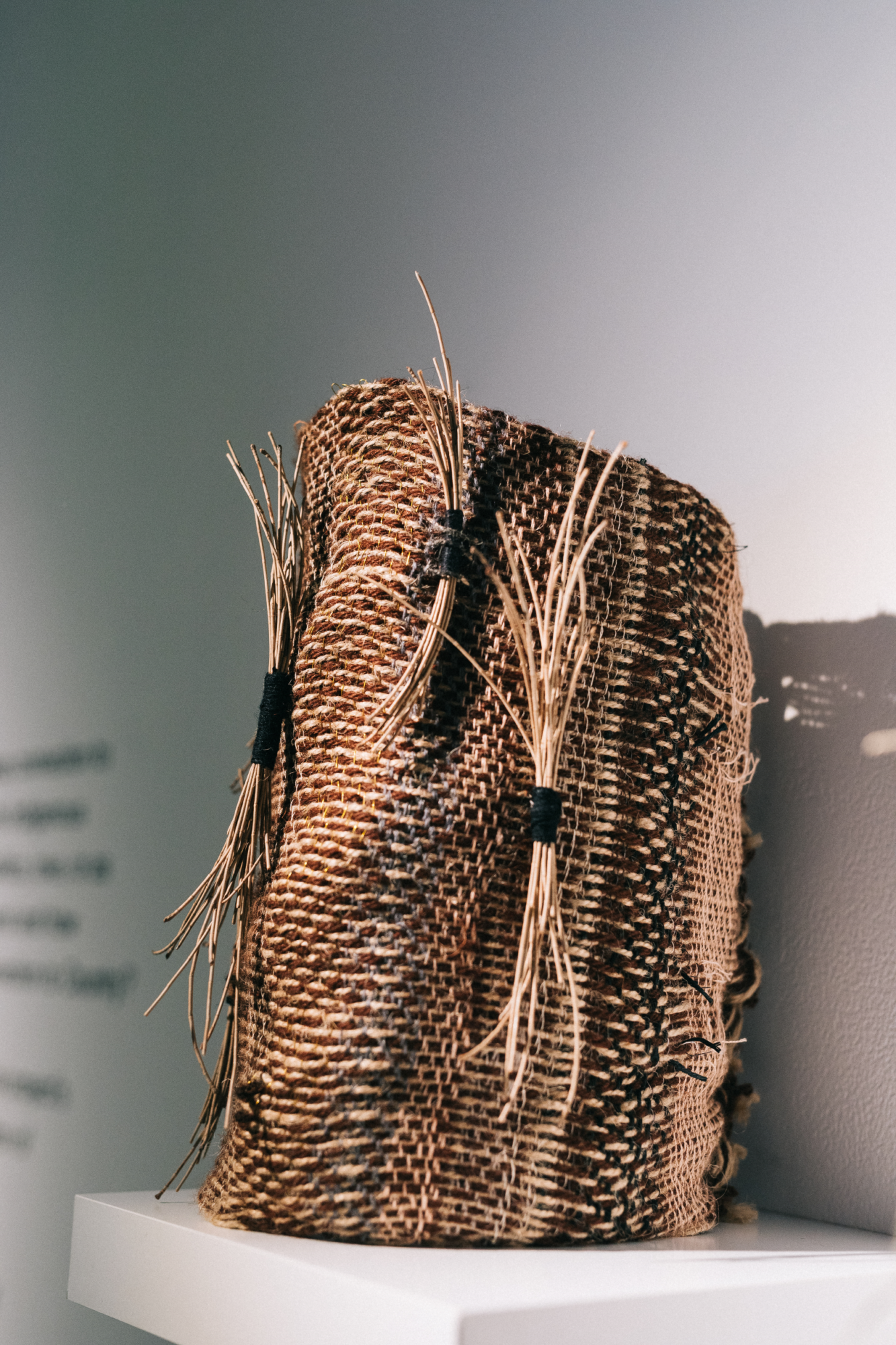
Image: Thomas McCammon
- Artwork I carry Country
- Artist Dameeli Coates, Wakka Wakka, born 1976
- Year 2021
- Medium jute, recycled wool, reeds, sheoak nettles, dimensions vary
- Size dimensions vary
Work created in Tarntanya, Adelaide (Kaurna Land)
Courtesy of the artist
I carry Country: explores the way Aboriginal Australians who live “off country” and overseas maintain and connect to identity and culture when they are not on their ancestral lands. In a globalised world with greater movement, how do we maintain the central tenets of our cultures? It looks at the impact of colonial concepts of land and the importance of belonging.
The design pieces created with recycled and discarded wool, cotton and linen yarns and natural reeds and materials from my mother’s garden, explore these concepts of connection to country through sound and texture, creating e-textile pieces that carry the sounds of home and country when touched.
The texture of the pieces are reminiscent of scratchy mission blankets and the diseases blankets have brought with them, infused with the sounds of country to me and those of my relationships.
-
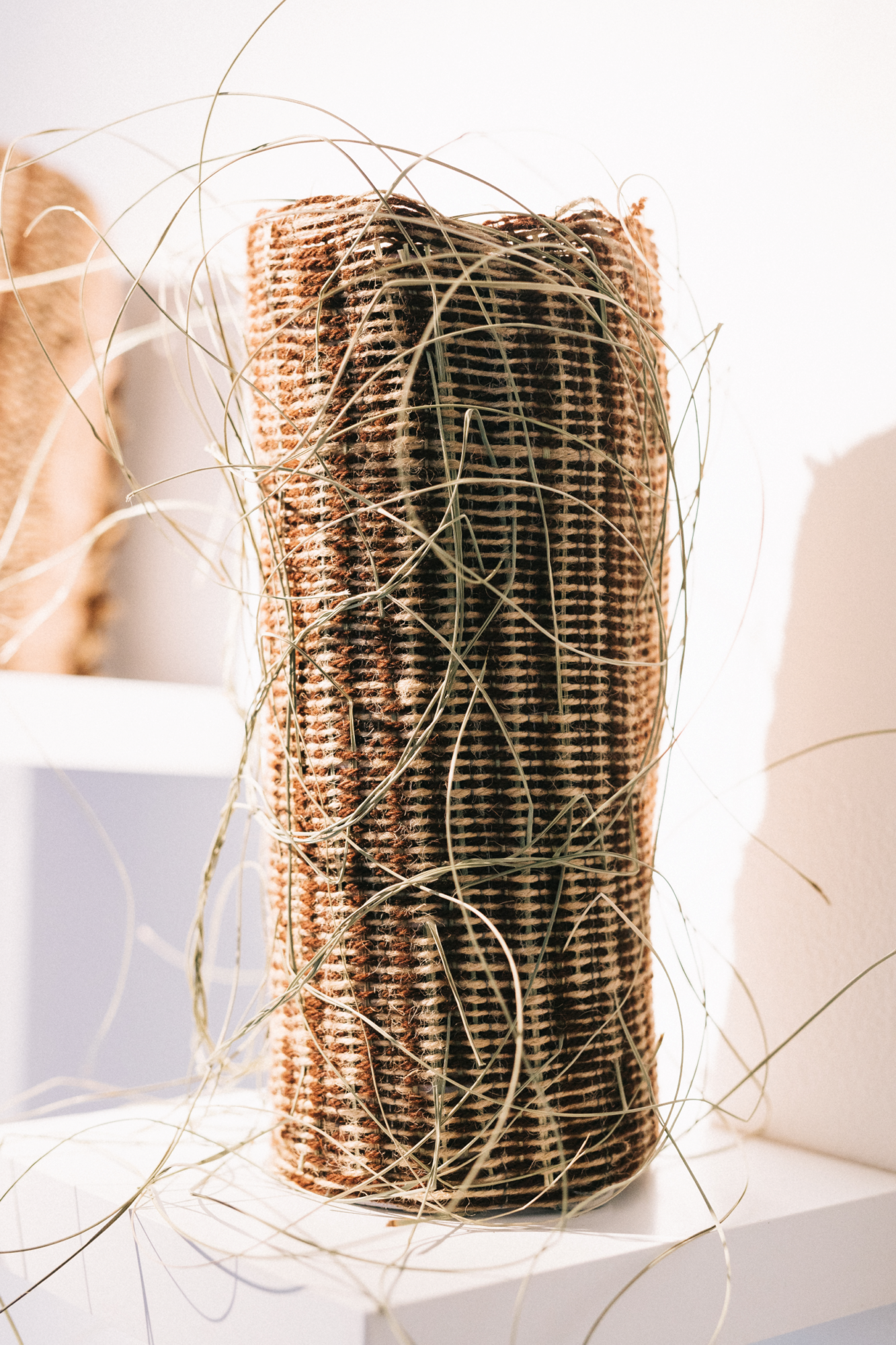
Photo: Thomas McCammon
- Artwork I carry Country
- Artist Dameeli Coates, Wakka Wakka, born 1976
- Year 2021
- Medium jute, recycled wool, reeds, sheoak nettles, dimensions vary
- Size dimensions vary
Work created in Tarntanya, Adelaide (Kaurna Land)
Courtesy of the artist
I carry Country: explores the way Aboriginal Australians who live “off country” and overseas maintain and connect to identity and culture when they are not on their ancestral lands. In a globalised world with greater movement, how do we maintain the central tenets of our cultures? It looks at the impact of colonial concepts of land and the importance of belonging.
The design pieces created with recycled and discarded wool, cotton and linen yarns and natural reeds and materials from my mother’s garden, explore these concepts of connection to country through sound and texture, creating e-textile pieces that carry the sounds of home and country when touched.
The texture of the pieces are reminiscent of scratchy mission blankets and the diseases blankets have brought with them, infused with the sounds of country to me and those of my relationships.
-
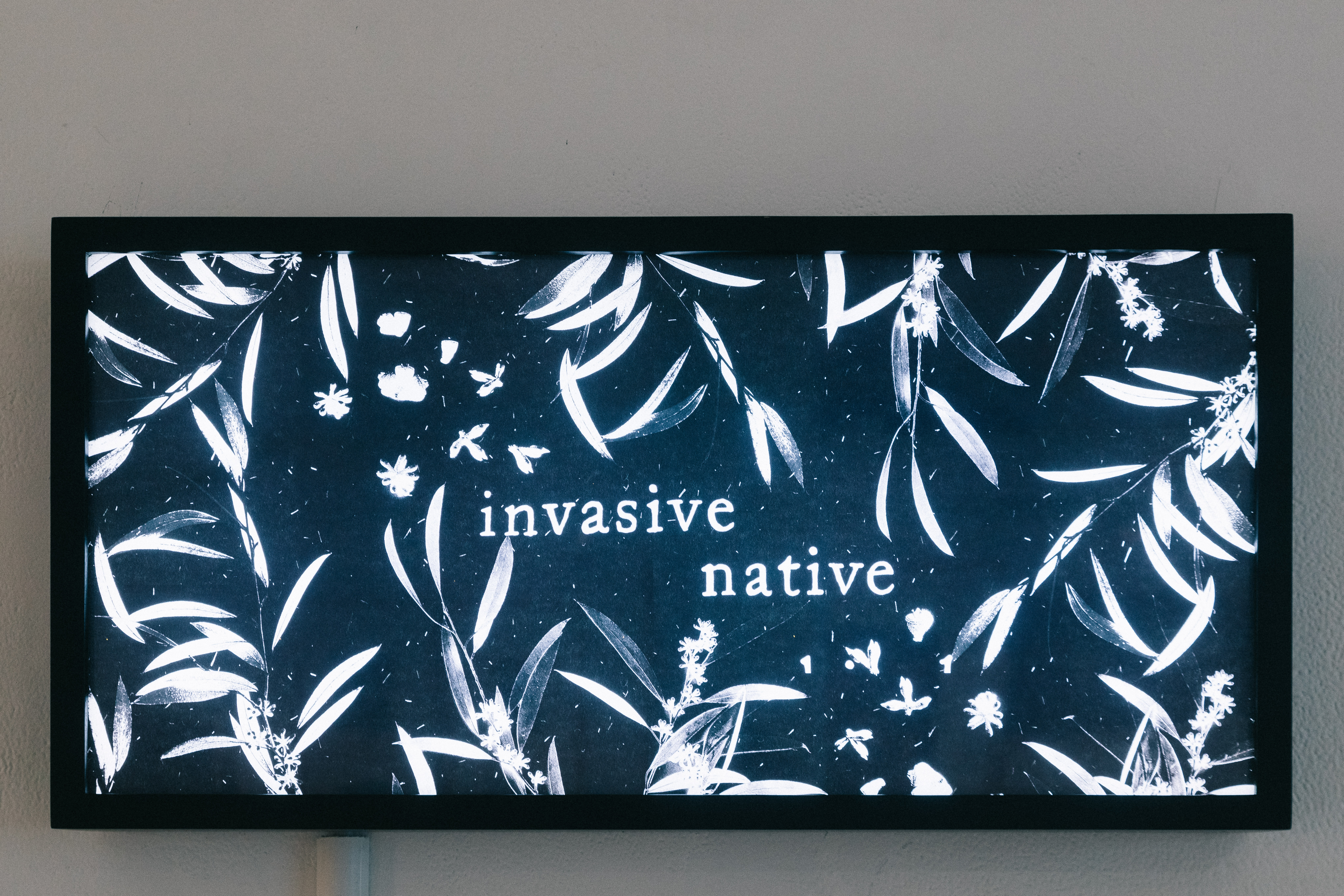
Photo: Thomas McCammon
- Artwork Light of an Invasive Native
- Artist Jenna Lee, Larrakia, Karajarri, Wardaman, born 1992
- Year 2021
- Medium lightbox
- Size 60 x 32 x 8 cm
Work created in Naarm, Melbourne (Boon Wurrung and Woi Wurrung)
Courtesy of the artist and MARS gallery
‘Light of an Invasive Native’ depicts the pitch-black darkness of museum collection stores as well as the resulting light and energy that radiates when our botanical and cultural collections are accessed and activated. This exchange of energy between people, collection and object is made possible only when we as First Nations people and communities have the agency to activate these archives – transforming them into living, breathing spaces, no longer silent but part of the continuous cycle of culture. This energy exchange also speaks to the universal connectedness between caring for Country, our plants and our cultural objects and practices. By caring for our land we have access to the plants, fibres and pigments which we transform into objects and artwork, which maintain and preserve our culture.
-
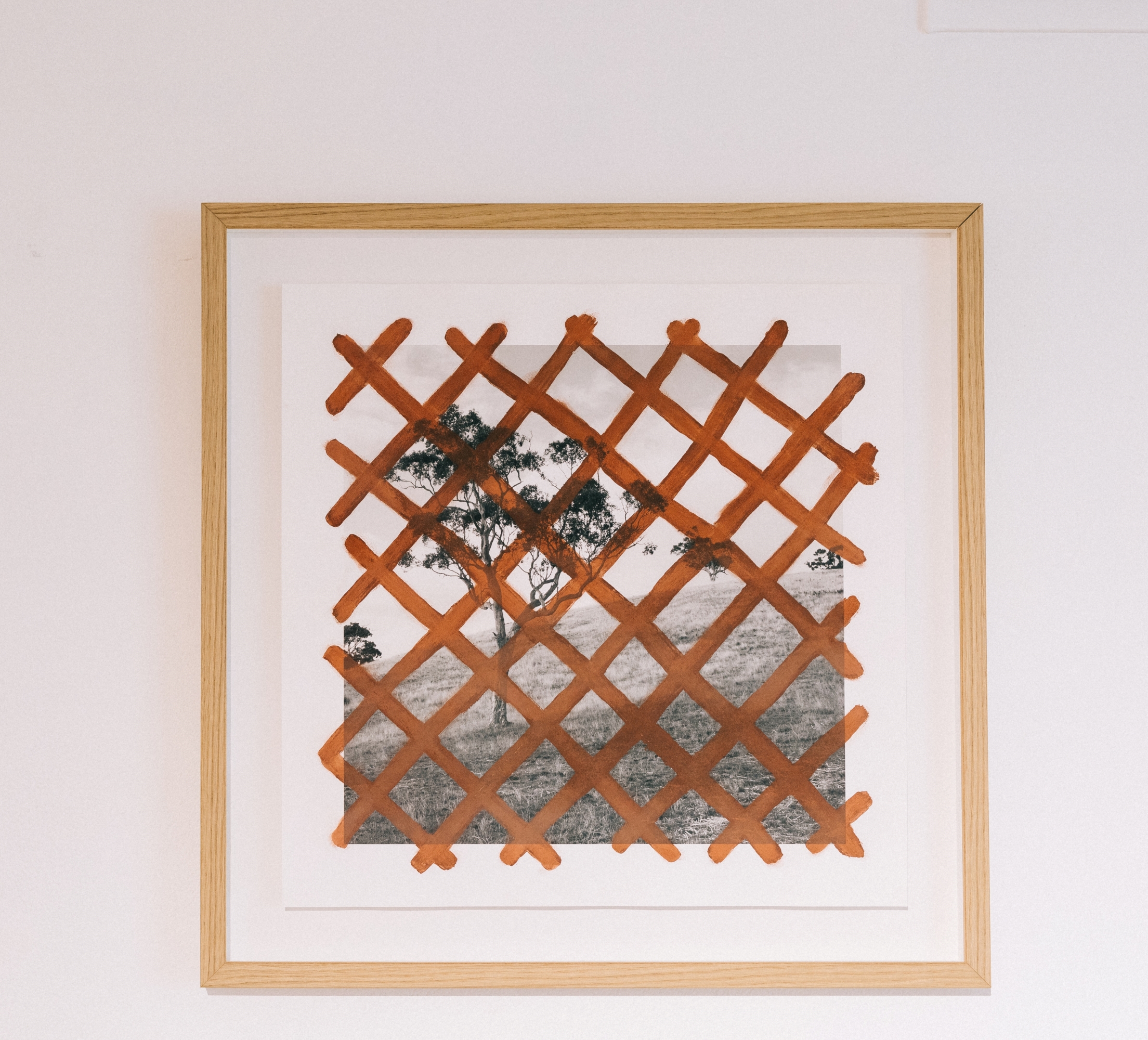
Photo: Thomas McCammon
- Artwork Turalayinthi Yarta (Marrmiyurna)
- Artist James Tylor, Kaurna, born 1986
- Year 2017
- Medium photograph with ochre
- Size 63 x 63 cm
Work created in Tarntanya, Adelaide (Kaurna Land)
Courtesy of the artist and N.Smith Gallery
This series explores my connection with Kaurna yarta (Kaurna land) through learning, researching, documenting and traveling on country. Turalayinthi Yarta is a Kaurna Miyurna phrase “to see yourself in the landscape” or “landscape photography”. In a two year period I travelled over 300 km of the southern part of the Hans Heysen trail that runs parallel along the Kaurna Yarta nation boundary line in the Mount Lofty ranges. Combining photographs and traditional Nunga**designs to represent my connection with this Kaurna Yarta region of South Australia.
The Heysen trail runs through the Mount Lofty and Flinders ranges from Cape Jervis in the south to Wilpena pound in the north. The Heysen trail named after the renown German Australian colonial landscape painter Sir Hans Heysen. The 1200km long trail passes over many different Nunga nations such as Ramindjeri, Ngarrindjeri, Kaurna Miyurna, Peramangk, Ngadjuri, Adnyamathanha, and Nukunu lands. I have attempted to acknowledge these Nunga nations throughout this series with traditional language and design.
The photographs of the landscape document different regions, and environments of Kaurna Yarta and the surrounding Nunga region. Painting over the European medium of photography with ochre, pipeclay and charcoal with Nunga designs to represent Nunga people’s intellectual, spiritual and physical connection with yarta (Country). The ochre and charcoal on the photographs is a physical presentation of the landscape on the photographs.
My Nunga Kaurna Miyurna family has been in the region of South Australia for 65,000- 80,000 years and has a rich cultural connection to this land. It is a great honour for me as a Kaurna Miyu person to learn, practice and walk in my ancestors footsteps. This series acknowledges and pays respect to Nunga people and their rich cultural, spiritual and physical connection to this landscape of South Australia.
*Yarta means Land, Country and Nation in Kaurna language
**Nunga means South Australian Aboriginal people or person (Nunga language)
Note: The Kaurna spelling has been revised to the new Kaurna spelling -
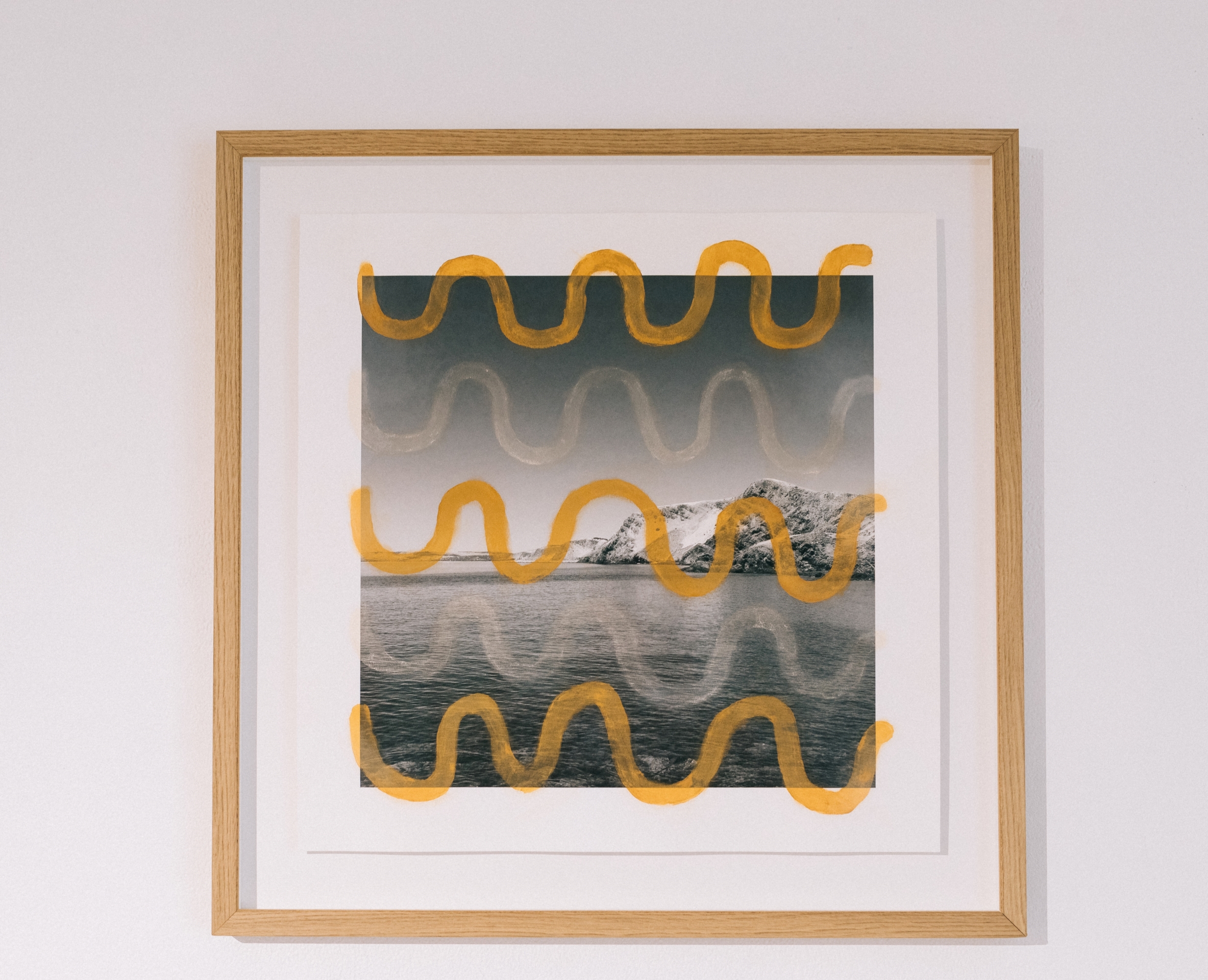
Photo: Thomas McCammon
- Artwork Turalayinthi Yarta (Yarlu)
- Artist James Tylor, Kaurna, born 1986
- Year 2017
- Medium photograph with ochre and pipeclay
- Size 63 x 63 cm
Work created in Tarntanya, Adelaide (Kaurna Land)
Courtesy of the artist and N.Smith Gallery
This series explores my connection with Kaurna yarta (Kaurna land) through learning, researching, documenting and traveling on country. Turalayinthi Yarta is a Kaurna Miyurna phrase “to see yourself in the landscape” or “landscape photography”. In a two year period I travelled over 300 km of the southern part of the Hans Heysen trail that runs parallel along the Kaurna Yarta nation boundary line in the Mount Lofty ranges. Combining photographs and traditional Nunga**designs to represent my connection with this Kaurna Yarta region of South Australia.
The Heysen trail runs through the Mount Lofty and Flinders ranges from Cape Jervis in the south to Wilpena pound in the north. The Heysen trail named after the renown German Australian colonial landscape painter Sir Hans Heysen. The 1200km long trail passes over many different Nunga nations such as Ramindjeri, Ngarrindjeri, Kaurna Miyurna, Peramangk, Ngadjuri, Adnyamathanha, and Nukunu lands. I have attempted to acknowledge these Nunga nations throughout this series with traditional language and design.
The photographs of the landscape document different regions, and environments of Kaurna Yarta and the surrounding Nunga region. Painting over the European medium of photography with ochre, pipeclay and charcoal with Nunga designs to represent Nunga people’s intellectual, spiritual and physical connection with yarta (Country). The ochre and charcoal on the photographs is a physical presentation of the landscape on the photographs.
My Nunga Kaurna Miyurna family has been in the region of South Australia for 65,000- 80,000 years and has a rich cultural connection to this land. It is a great honour for me as a Kaurna Miyu person to learn, practice and walk in my ancestors footsteps. This series acknowledges and pays respect to Nunga people and their rich cultural, spiritual and physical connection to this landscape of South Australia.
*Yarta means Land, Country and Nation in Kaurna language
**Nunga means South Australian Aboriginal people or person (Nunga language)
Note: The Kaurna spelling has been revised to the new Kaurna spelling -
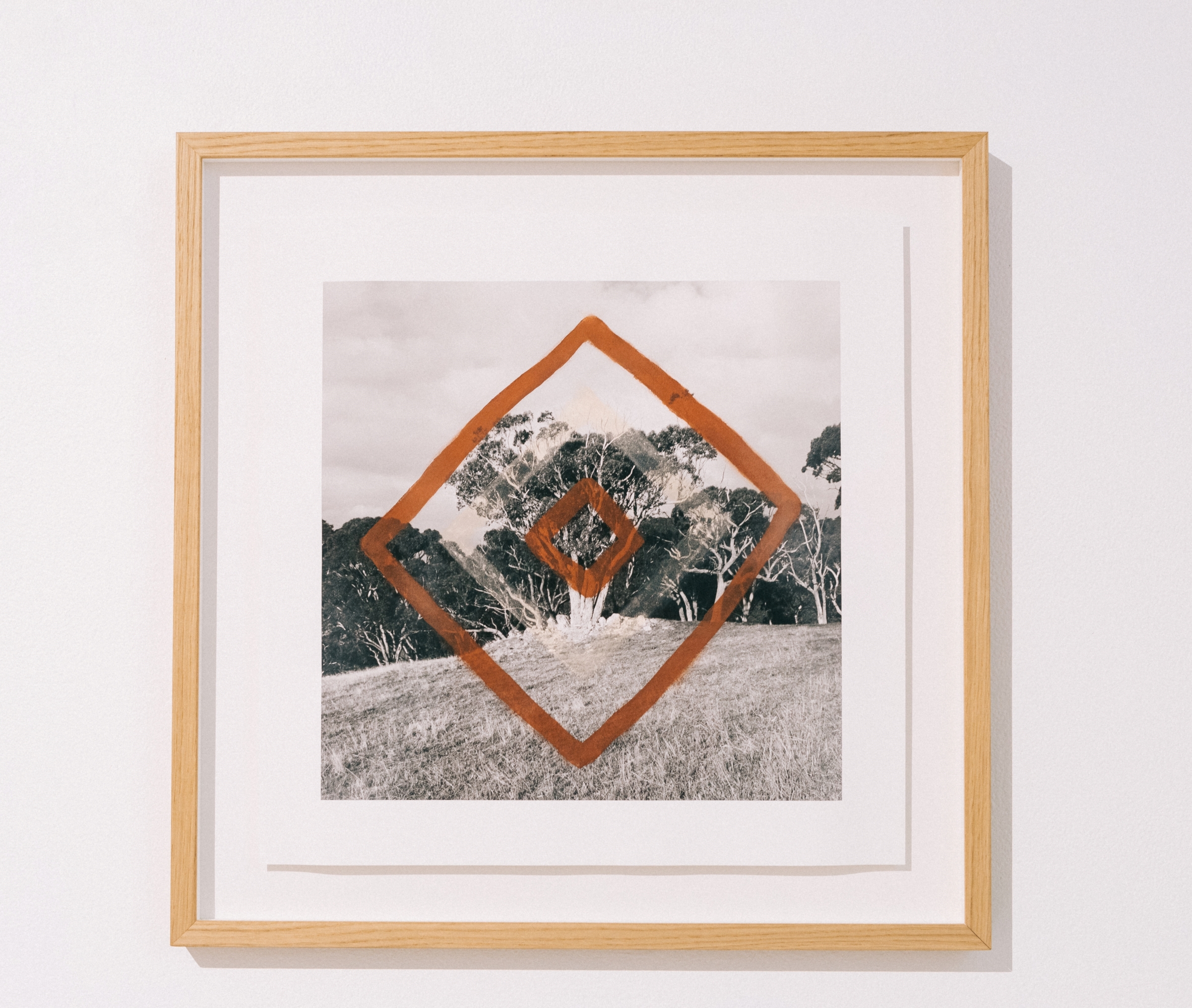
Photo: Thomas McCammon
- Artwork Turalayinthi Yarta (Mukurta)
- Artist James Tylor, Kaurna, born 1986
- Year 2017
- Medium photograph with ochre and pipeclay
- Size 63 x 63 cm
Work created in Tarntanya, Adelaide (Kaurna Land)
Courtesy of the artist and N.Smith Gallery
This series explores my connection with Kaurna yarta (Kaurna land) through learning, researching, documenting and traveling on country. Turalayinthi Yarta is a Kaurna Miyurna phrase “to see yourself in the landscape” or “landscape photography”. In a two year period I travelled over 300 km of the southern part of the Hans Heysen trail that runs parallel along the Kaurna Yarta nation boundary line in the Mount Lofty ranges. Combining photographs and traditional Nunga**designs to represent my connection with this Kaurna Yarta region of South Australia.
The Heysen trail runs through the Mount Lofty and Flinders ranges from Cape Jervis in the south to Wilpena pound in the north. The Heysen trail named after the renown German Australian colonial landscape painter Sir Hans Heysen. The 1200km long trail passes over many different Nunga nations such as Ramindjeri, Ngarrindjeri, Kaurna Miyurna, Peramangk, Ngadjuri, Adnyamathanha, and Nukunu lands. I have attempted to acknowledge these Nunga nations throughout this series with traditional language and design.
The photographs of the landscape document different regions, and environments of Kaurna Yarta and the surrounding Nunga region. Painting over the European medium of photography with ochre, pipeclay and charcoal with Nunga designs to represent Nunga people’s intellectual, spiritual and physical connection with yarta (Country). The ochre and charcoal on the photographs is a physical presentation of the landscape on the photographs.
My Nunga Kaurna Miyurna family has been in the region of South Australia for 65,000- 80,000 years and has a rich cultural connection to this land. It is a great honour for me as a Kaurna Miyu person to learn, practice and walk in my ancestors footsteps. This series acknowledges and pays respect to Nunga people and their rich cultural, spiritual and physical connection to this landscape of South Australia.
*Yarta means Land, Country and Nation in Kaurna language
**Nunga means South Australian Aboriginal people or person (Nunga language)
Note: The Kaurna spelling has been revised to the new Kaurna spelling -
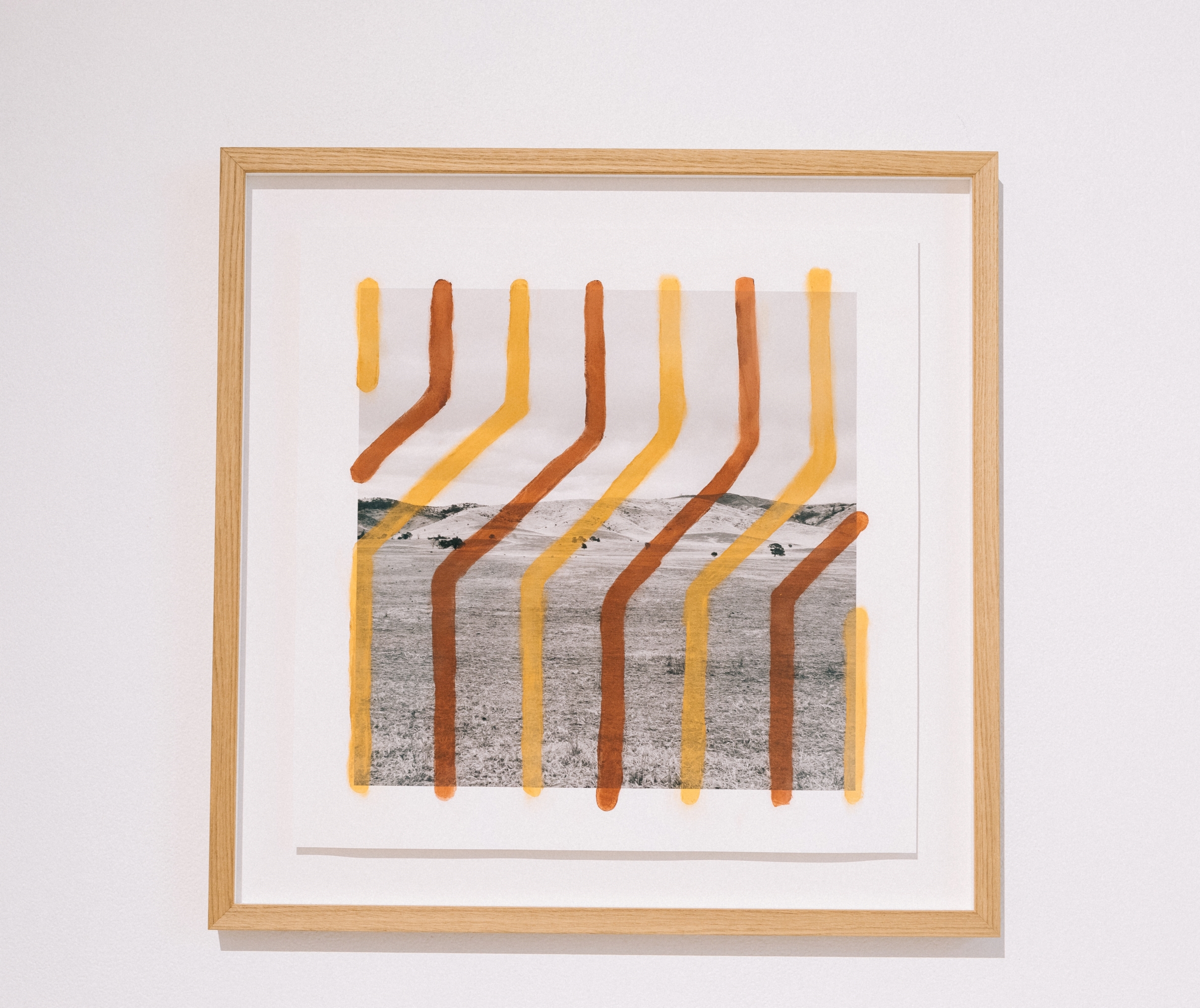
Photo: Thomas McCammon
- Artwork Turalayinthi Yarta (Wirramiyu)
- Artist James Tylor, Kaurna, born 1986
- Year 2017
- Medium photograph with ochre
- Size 63 x 63 cm
Work created in Tarntanya, Adelaide (Kaurna Land)
Courtesy of the artist and N.Smith Gallery
This series explores my connection with Kaurna yarta (Kaurna land) through learning, researching, documenting and traveling on country. Turalayinthi Yarta is a Kaurna Miyurna phrase “to see yourself in the landscape” or “landscape photography”. In a two year period I travelled over 300 km of the southern part of the Hans Heysen trail that runs parallel along the Kaurna Yarta nation boundary line in the Mount Lofty ranges. Combining photographs and traditional Nunga**designs to represent my connection with this Kaurna Yarta region of South Australia.
The Heysen trail runs through the Mount Lofty and Flinders ranges from Cape Jervis in the south to Wilpena pound in the north. The Heysen trail named after the renown German Australian colonial landscape painter Sir Hans Heysen. The 1200km long trail passes over many different Nunga nations such as Ramindjeri, Ngarrindjeri, Kaurna Miyurna, Peramangk, Ngadjuri, Adnyamathanha, and Nukunu lands. I have attempted to acknowledge these Nunga nations throughout this series with traditional language and design.
The photographs of the landscape document different regions, and environments of Kaurna Yarta and the surrounding Nunga region. Painting over the European medium of photography with ochre, pipeclay and charcoal with Nunga designs to represent Nunga people’s intellectual, spiritual and physical connection with yarta (Country). The ochre and charcoal on the photographs is a physical presentation of the landscape on the photographs.
My Nunga Kaurna Miyurna family has been in the region of South Australia for 65,000- 80,000 years and has a rich cultural connection to this land. It is a great honour for me as a Kaurna Miyu person to learn, practice and walk in my ancestors footsteps. This series acknowledges and pays respect to Nunga people and their rich cultural, spiritual and physical connection to this landscape of South Australia.
*Yarta means Land, Country and Nation in Kaurna language
**Nunga means South Australian Aboriginal people or person (Nunga language)
Note: The Kaurna spelling has been revised to the new Kaurna spelling -
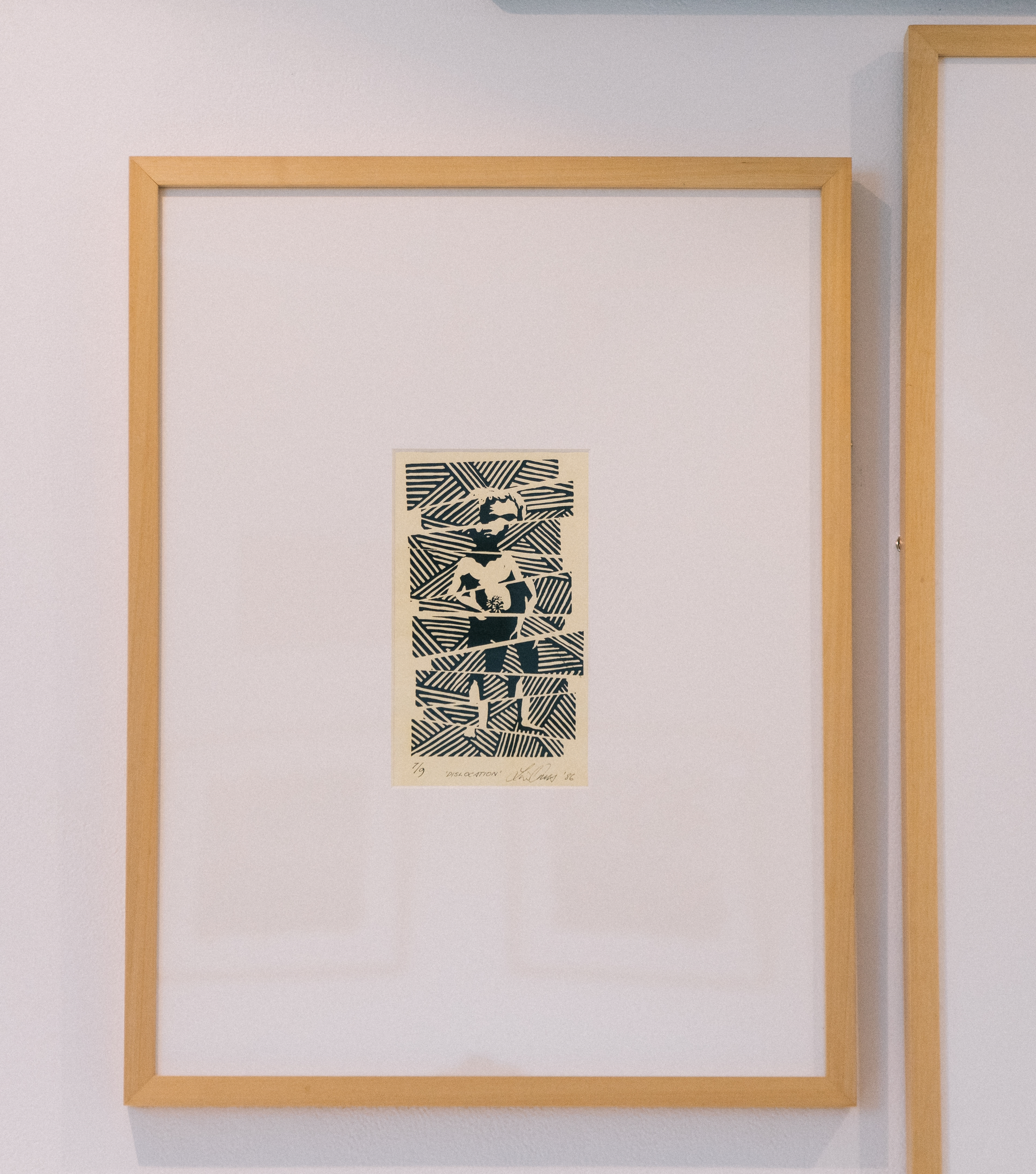
Photo: Thomas McCammon
- Artwork Dislocation
- Artist Lin Onus, Yorta Yorta, born 1948, died 1996
- Year 1986
- Medium linocut, ink on buff paper, edition 93/100
- Size 20.7 x 29.6 cm
Work created in Melbourne (Boon Wurrung and Woi Wurrung)
Collection of Flinders University Museum of Art 2300
© Lin Onus Estate/Copyright Agency, 2022
-
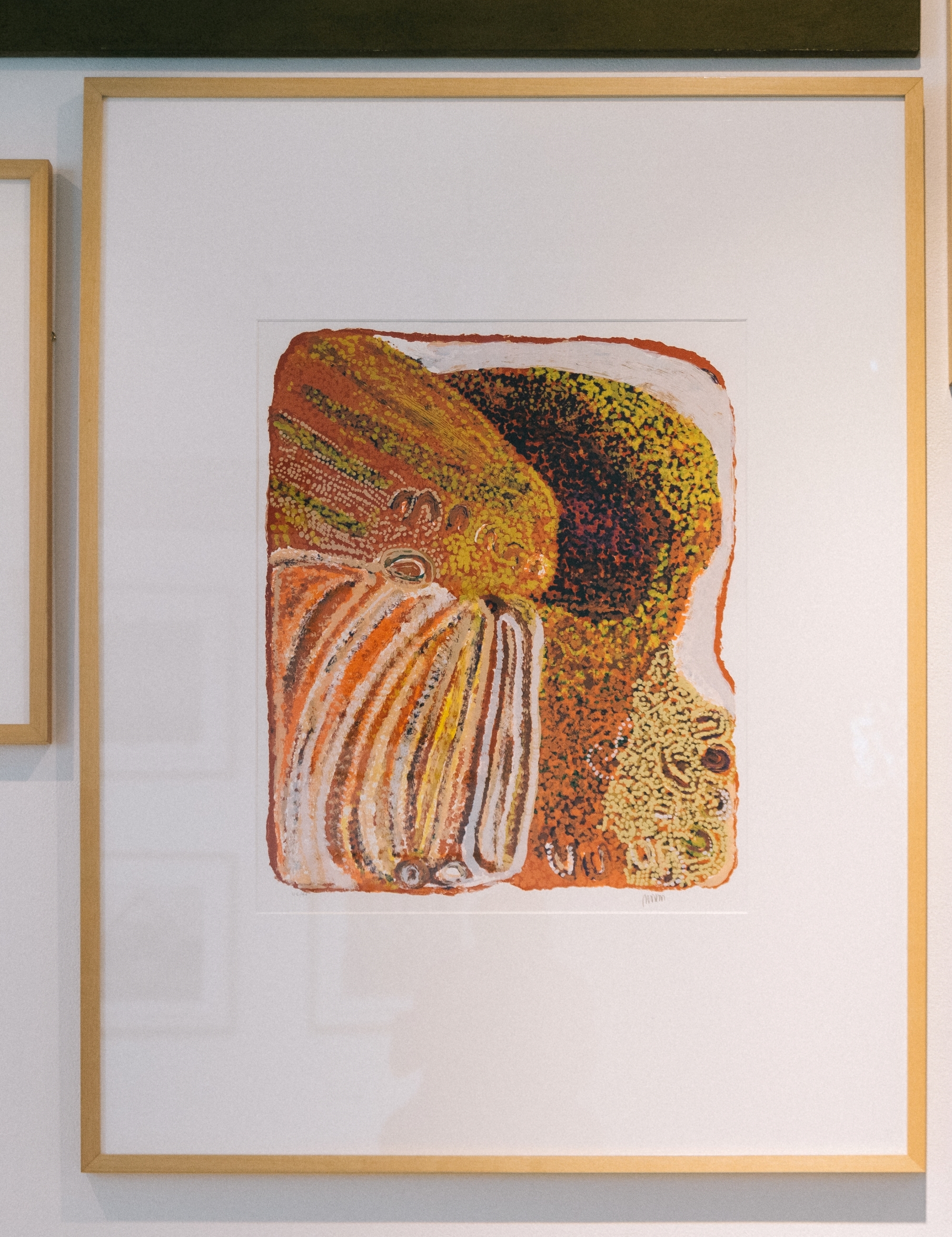
Photo: Thomas McCammon
- Artwork Nakarra Nakarra (Seven Sisters Dreaming), from the portfolio Yilpinji: Love Magic Ceremony
- Artist Eubena Nampitjin, Wangkajunga, born circa 1930, died 2013
- Year 2003
- Medium screenprint, coloured inks on paper
- Size 76 x 56 cm, edition 44/99
Gift of an anonymous donor
Collection of Flinders University Museum of Art 4277.003
© Eubena Nampitjin/Copyright Agency, 2022
-
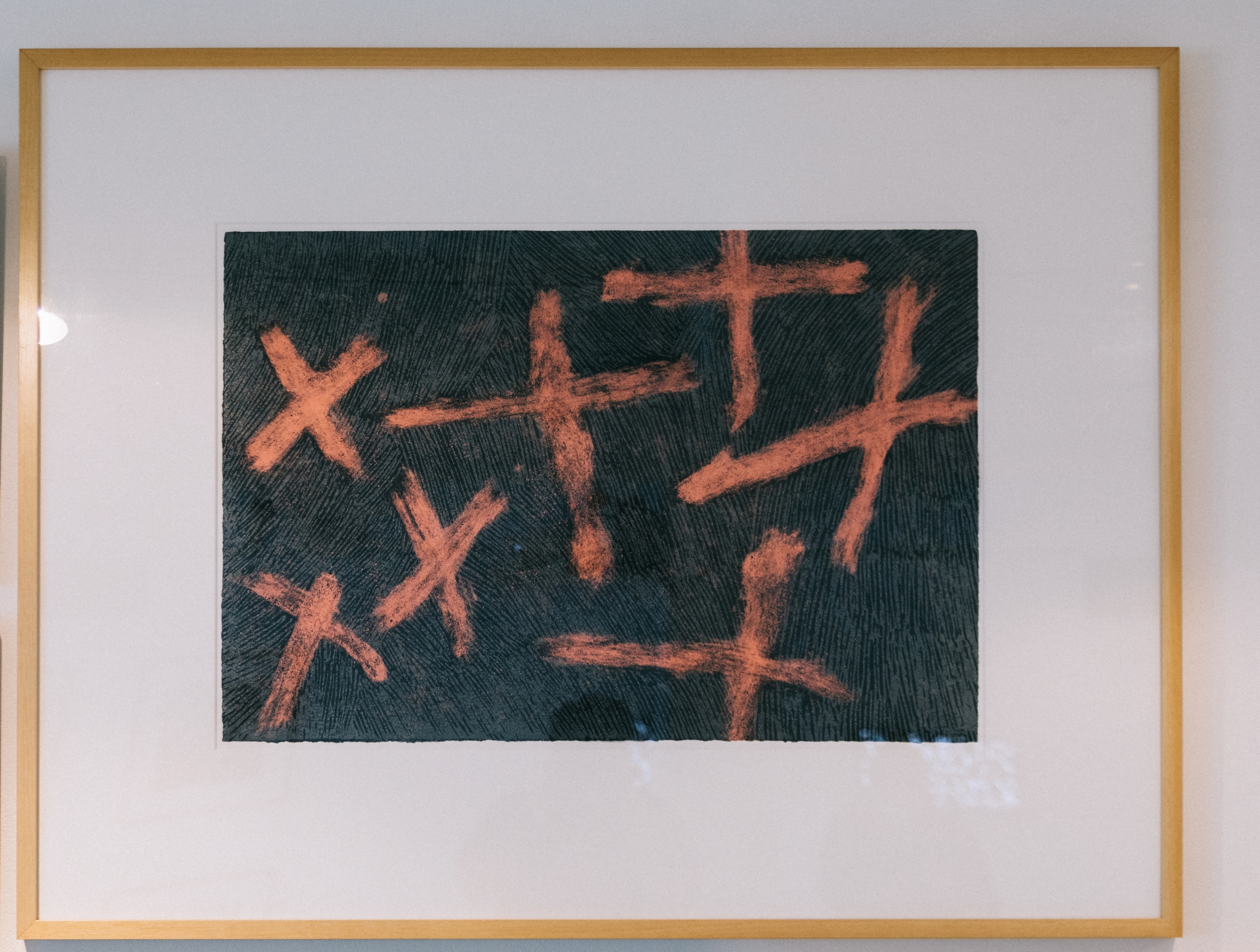
Photo: Thomas McCammon
- Artwork Djulpan, Seven Sisters
- Artist Nyapanyapa Yunupingu, Gumatj, Yolngu, born 1945, died 2021
- Year 2020
- Medium collagraph and screenprint screenprint, coloured inks on paper
- Size 53 x 78 cm (sheet), edition 26/40
Work created in Yirrkala, East Arnhem Land, Northern Territory
Collection of Flinders University Museum of Art 5967
© the artist’s estate
-
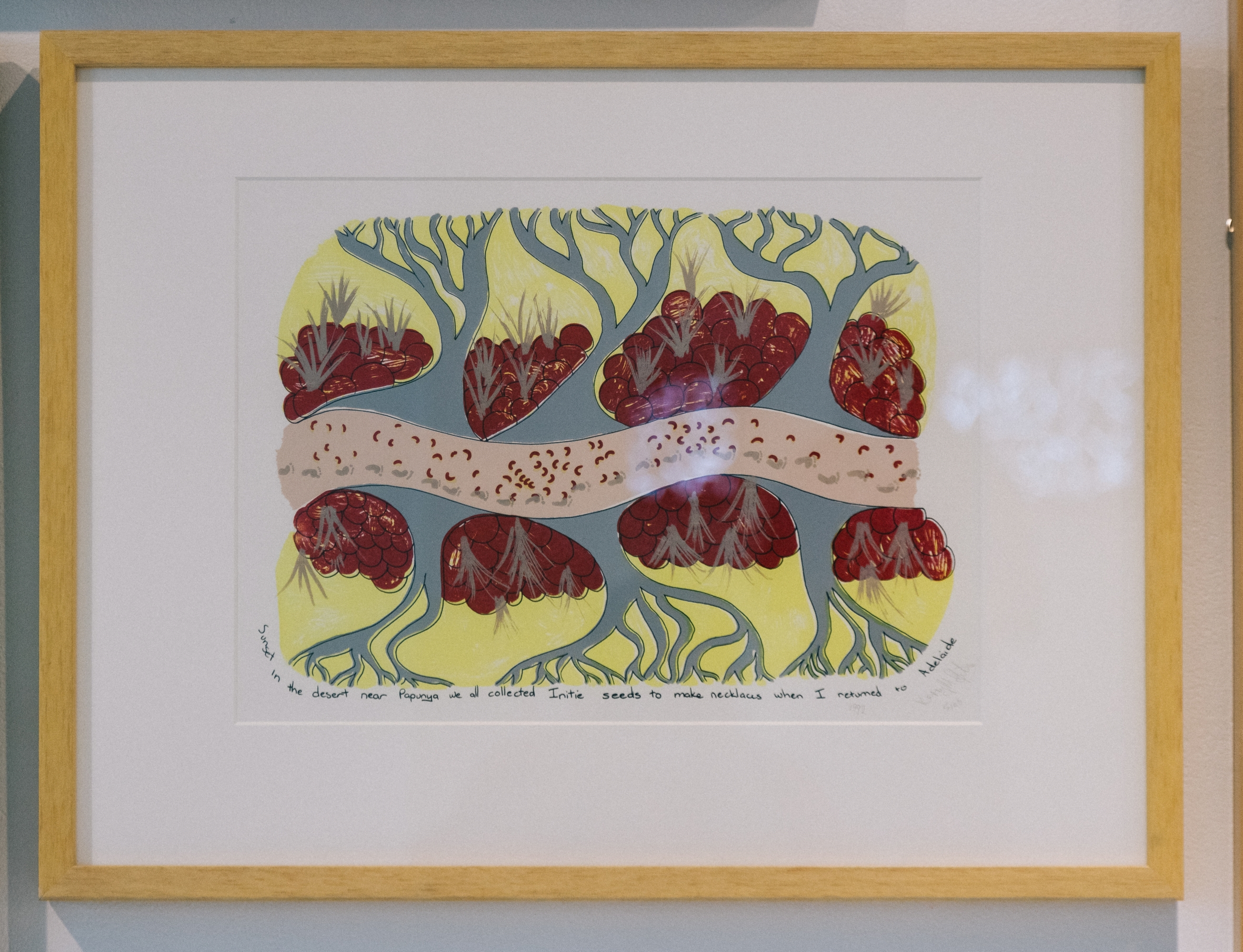
Photo: Thomas McCammon
- Artwork Collecting Initie seeds in the desert
- Artist Kerry Giles, Ngarrindjeri, born 1959, died 1997
- Year 1992
- Medium screenprint, coloured inks on paper
- Size 36.8 x 47 cm (sheet), edition 5/46
Work created in Tarntanya, Adelaide (Kaurna Land)
Collection of Flinders University Museum of Art 2873
© the artist’s estate
-
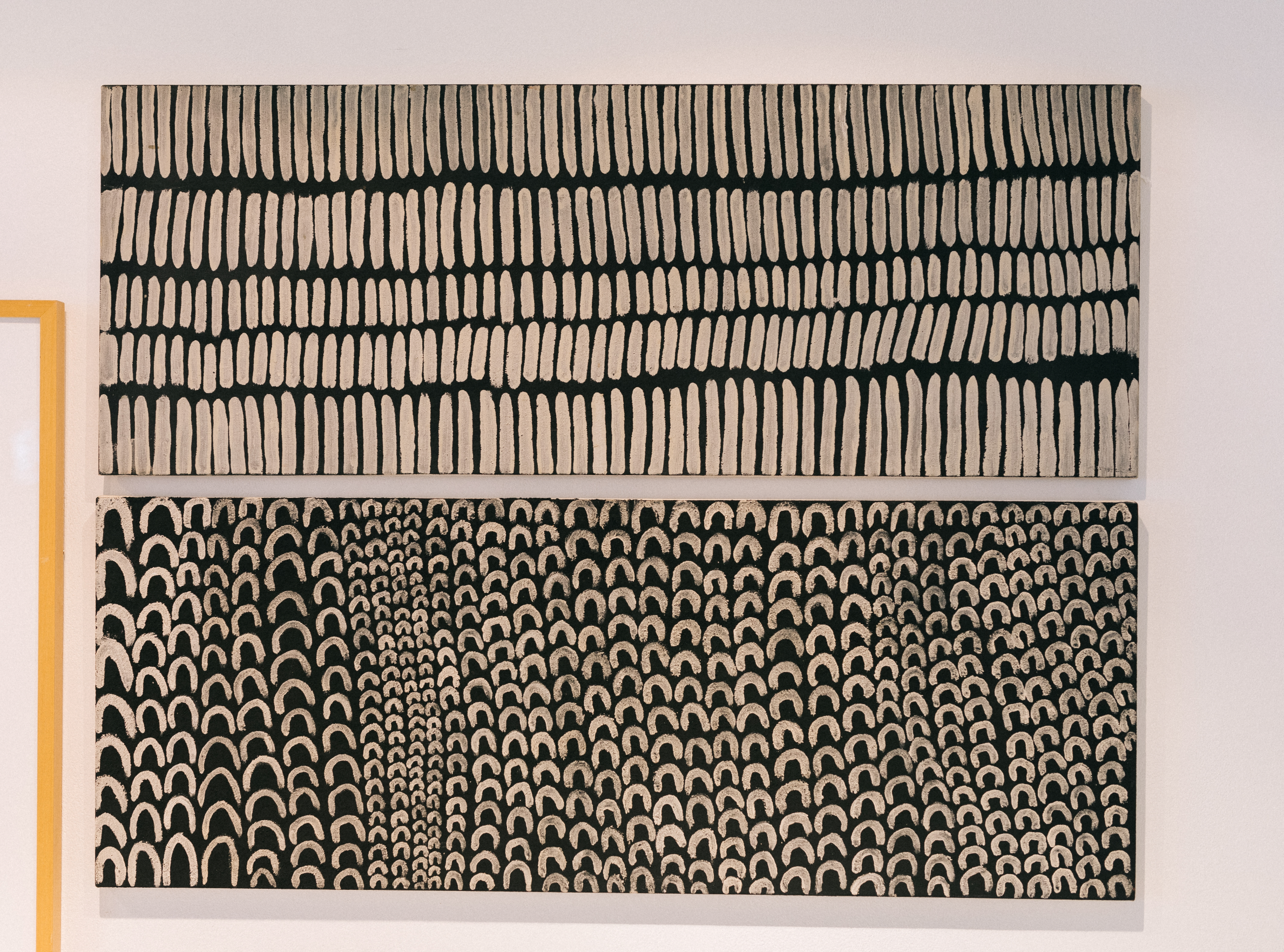
Photo: Thomas McCammon
- Artwork Jimbala and Lilmin
- Artist Lena Nyadbi, Kija/ Gidja, born circa 1936
- Year 2002
- Medium natural pigments on canvas
- Size 45 x 120 cm (top panel) 45 x 120 cm (bottom panel)
-
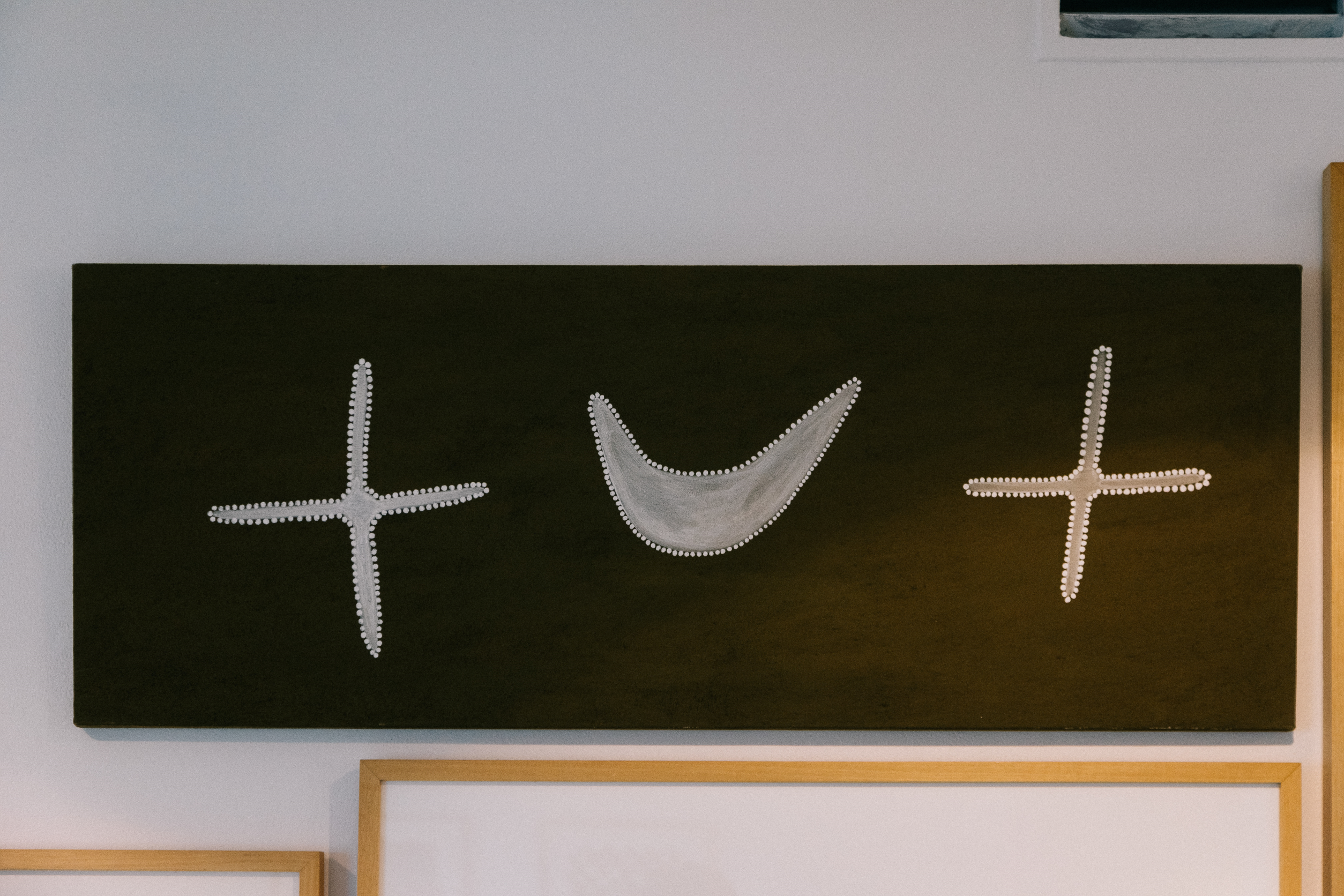
Photo: Thomas McCammon
- Artwork Karrngin Ngarrangkarni
- Artist Mabel Juli, Kija/ Gidja, born circa 1933
- Year 2002
- Medium natural pigments on canvas
- Size 45 x 120 cm
Work created in Warmun, East Kimberley, Western Australia (Gija)
Donated through the Australian Government’s Cultural Gifts Program by Stephanie and Julian Grose
Collection of Flinders University Museum of Art 4978
© Mabel Juli/Copyright Agency, 2022
Meet the artists & curators
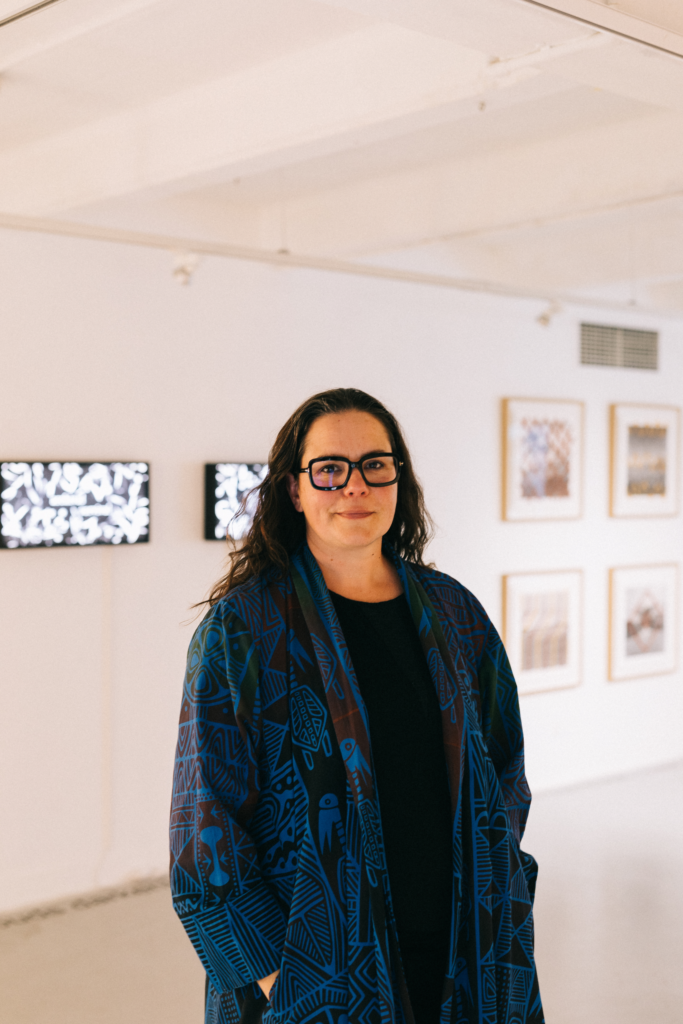
Dameeli Coates is a Wakka Wakka woman whose matriarchal family are from Southern Queensland. She is a mother, sister, textile artist and designer who grew up on Kaurna Yarta. She spent 20 years working as a Human Rights campaigner in Indigenous affairs. She has an Honours degree in Textile Design from Central Saint Martin’s College, London. Her curatorial interests stem from her Honours research, examining the relationships between dispossession, displacement and settler colonial borders on Indigenous identities and collective sense of belonging.





